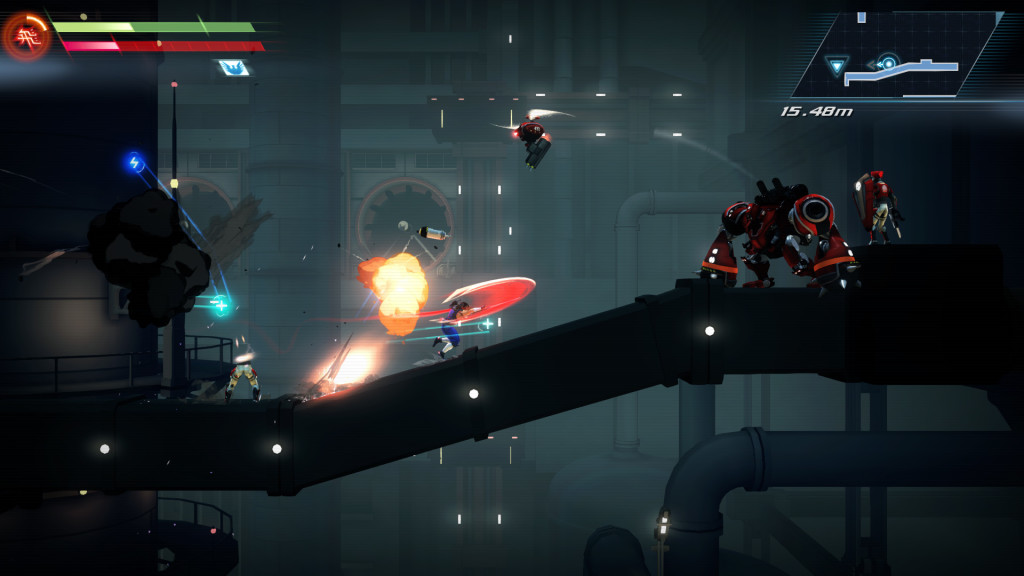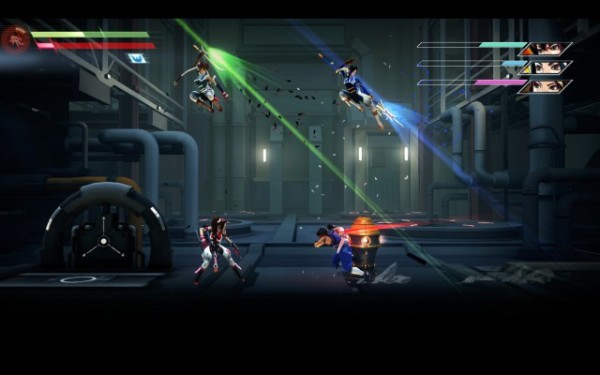Review: Strider [PC]
/ It took awhile, but Strider was brought back to the spotlight thanks to studio Double Helix (Killer Instinct) and oh, did they do a great job at staying true to the original content. A fast-paced download only game that keeps you hooked with non-stop action and level design that we think should be used more often in future platformers. Flailing a sword around at blazing speeds never felt this satisfying.
It took awhile, but Strider was brought back to the spotlight thanks to studio Double Helix (Killer Instinct) and oh, did they do a great job at staying true to the original content. A fast-paced download only game that keeps you hooked with non-stop action and level design that we think should be used more often in future platformers. Flailing a sword around at blazing speeds never felt this satisfying.
Quick - that is the best way to describe this action-adventure platformer. You play as the famous Strider Hiryu, a ninja with one simple task -- take down the evil Grandmaster Meio in the heavily fortified metropolis of Kazakh City. Right off the bat, with not much of an introduction about anything, you find Hiryu gliding into the city along with the first wave of enemies ready to warm your blade. There’s never a dull moment in Strider. Every room is filled with enemies to engage, and based on the level of your performance, you may clear even the most challenging areas in just seconds. The better you understand your enemies, the faster the game gets. Strider is all about the action; it doesn’t bother giving much explanation or character progression at all. No backstory of Strider Hiryu’s past or why he wants to take down Grandmaster Meio. That’s just how it is, and this game works well that way. The cheesy lines are already bad enough, but once the short dialogue in between boss fights and new locations end, the fun continues.
The most appealing part of the game is its level design. It greatly reminded me of the old Metroid games on SNES, as well as the best Castlevania game in history – Castlevania: Symphony of the Night (well, that’s my opinion). It’s played as an open world side-scroller with upgrades and unlockables tucked away around this huge map waiting to be explored. Every locale in Kazakh City has its own unique visual and technical appeal. From the sewers to the military compound, each area you come across has its own personality, providing different ways to tackle the area. Some might be heavier on enemies, while some require you to watch where you jump. From combat to platforming, this game keeps on changing gears, preventing any repetitive tension.
Objectives are given to move forward in the game, but thanks to its Metroid style of level design, you get that feeling of wanting to just explore. As you progress, new weapons and skills are unlocked, which also serve as keys to certain locations in the city. You will find doors requiring a specific upgrade, and once you get it, you can’t help but backtrack to see what’s behind that door you couldn’t access. Controls are easy to grasp from the get-go, but they soon evolve as you get more abilities to use. There are some enemies that can only be defeated with specific abilities, but this doesn’t hinder the freedom of play, only adding to the fun and creative methods with which you can dispose of Grandmaster Meio’s henchmen.
You will eventually come across different flavors for Strider Hiryu’s preferred weapon – the plasma sword Cypher – which provide different properties depending which one you equip. One gives you the ability to deflect incoming projectiles, while another freezes enemies with a single touch. These are color-coded and can be switched anytime during play via the directional pad. This gives more depth to the combat, and at the end you’ll find yourself constantly switching Cyphers based on the current situation. From summoning mechanical animals to throwing kunai to extra movements like the addicting dash, gameplay evolves constantly throughout this 4-6 hour experience, keeping the combat from ever going dull.
Sadly, the game isn’t so difficult. So don’t come in expecting a challenge, even on its hardest difficulty. Every enemy has a pattern and once you learn how to exploit these patterns, you find yourself going through them, no sweat. This also applies to the bosses in the game, which have great mechanics I haven’t seen in a long time. Every boss I’ve experienced in Strider is memorable, especially that last fight which doesn’t make any sense at all (you’ll understand once you get there). You’re always left at the edge of your seat after every fight. Yes, it’s easy, but the combat is so satisfying that the lack of challenge didn’t rear itself as a problem for me. I find enjoyment in disposing of enemies in the fastest possible ways. Oh, and let’s not forget the soundtrack, which not only gives you a bit of nostalgia, but supports the gameplay very well in keeping you invested.
In between all the slashing, this is also a platforming game, with Strider Hiryu jumping, dashing, and climbing walls and roofs to reach the next area. Hiryu still moves just like he did back in the classic games. I consider it a big plus that Double Helix kept our hero true to the original. The classic cartwheel jump returns, as well as the upward slash you might see in previous games as well as in Marvel VS Capcom 2 or 3. Animations aside, the platforming elements aren’t a tedious feat thanks to the solid controls. You won’t find yourself fighting against how Strider moves, making the platforming aspect of the game a fun break from all the combat. You are always in control, so when things go the wrong way, it’s hard to fault the game’s design.
I’ve already mentioned that exploration is greatly encouraged, but the rewards you receive once you find new areas are very underwhelming. Some do give you upgrades like increased kunai range or increased life, but don’t quite give a good boost in the overall gameplay, making them something that can be ignored. You can also find a variety of concept art (which I believe should not be a reward for exploring), challenge maps, and trial maps that you can access in the main menu. Don’t be surprised with these maps though, since they provide little meat to the game. It’s a decent 5-minute experience of you either taking down waves of enemies or you reaching a certain spot in the world map the fastest way possible. You can also find new costumes for Strider Hiryu, which isn’t much of a plus, since they’re just different colors of the same outfit.
These additions may add to the replay value, but there’s no option to explore further once you enter the last part of the game. Once you finish it, you can’t reload and revisit places you haven’t explored. Instead, you lose your save, and you’ll have to replay the whole experience again. So, before entering the last part, make sure you’ve explored everything that interests you.
For a $15 download-only title, it’s definitely worth diving into a series we haven’t seen in years. The combat is satisfying, even if it tends to hurt the fingers with the constant need to swing your sword for hours. The visuals are colorful and look amazing in 60 FPS. Specific design touches like Strider Hiryu’s scarf and the returning bosses from previous games are well appreciated, making Strider a nice benchmark for developers looking to reboot a franchise. It stays true to the original content and exports it to a more modern look and feel. Whether you’re a fan of the series or have never tried Strider, you’ll be surprised how much fun you’ll have as Strider Hiryu.
SCORE: 9/10
Reviewer: Carlos Hernandez Strider was reviewed on the Windows PC platform Game completion was at 64% Recorded game time was at 6:25:00
PROS
- Quick combat
- Vast world map to explore
- Stays true to original content
- Memorable boss fights
CONS
- No option to revisit your playthrough after the last part of the game






